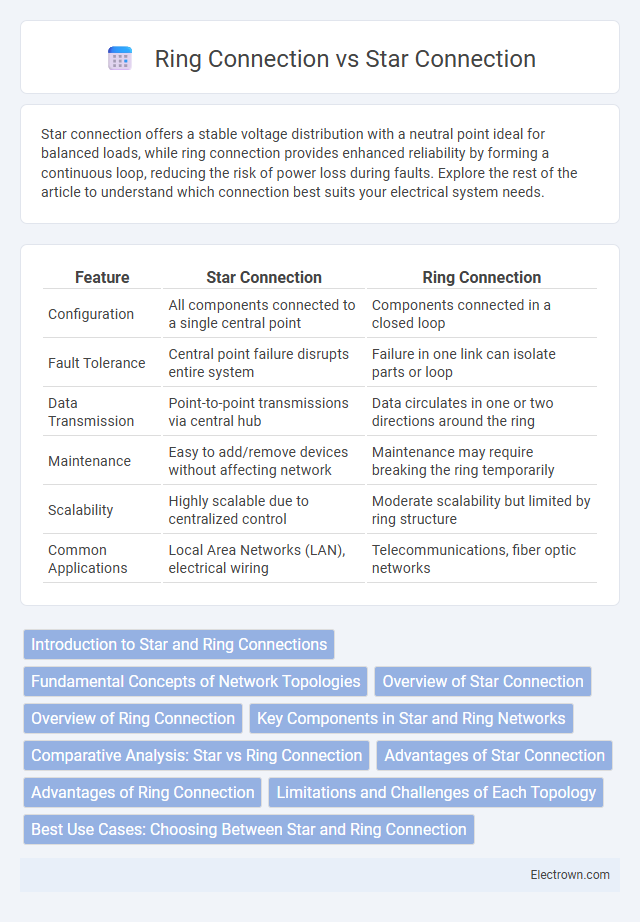Star connection offers a stable voltage distribution with a neutral point ideal for balanced loads, while ring connection provides enhanced reliability by forming a continuous loop, reducing the risk of power loss during faults. Explore the rest of the article to understand which connection best suits your electrical system needs.
Table of Comparison
| Feature | Star Connection | Ring Connection |
|---|---|---|
| Configuration | All components connected to a single central point | Components connected in a closed loop |
| Fault Tolerance | Central point failure disrupts entire system | Failure in one link can isolate parts or loop |
| Data Transmission | Point-to-point transmissions via central hub | Data circulates in one or two directions around the ring |
| Maintenance | Easy to add/remove devices without affecting network | Maintenance may require breaking the ring temporarily |
| Scalability | Highly scalable due to centralized control | Moderate scalability but limited by ring structure |
| Common Applications | Local Area Networks (LAN), electrical wiring | Telecommunications, fiber optic networks |
Introduction to Star and Ring Connections
Star connection features a central node where all electrical loads or sources connect, creating a configuration that enhances safety and simplifies fault identification in power distribution systems. Ring connection forms a closed loop circuit, ensuring continuous power flow even if one section is disrupted, widely used in network topologies for reliability. Each configuration offers distinct advantages depending on application requirements, such as load distribution, fault tolerance, and efficiency.
Fundamental Concepts of Network Topologies
Star connection features a central node acting as a hub where each device connects individually, enabling easy fault isolation and network management. Ring connection forms a closed loop, with each device linked to two neighbors, facilitating data transmission in a unidirectional or bidirectional manner. Fundamental concepts highlight star topology's robustness in handling node failures without network disruption, while ring topology ensures consistent data flow through token passing or similar protocols.
Overview of Star Connection
Star connection, also known as a wye connection, involves connecting all three phase windings or loads to a common neutral point, forming a Y-shaped configuration. This configuration allows for both phase voltage and line voltage to be utilized, with the line voltage being 3 times the phase voltage, making it suitable for balanced load distribution in three-phase power systems. Star connections improve system safety by providing a neutral point for grounding, which helps stabilize the voltage and minimizes the risk of electrical faults.
Overview of Ring Connection
Ring connection is a network topology where each device connects to exactly two other devices, forming a continuous loop or ring. Data travels in one direction around the ring, ensuring that each device receives and passes on the information until it reaches the intended recipient. This setup offers fault tolerance by allowing data rerouting in case of a single connection failure, enhancing network reliability.
Key Components in Star and Ring Networks
Star connection networks consist of a central hub or switch that connects multiple devices via individual cables, ensuring efficient data transmission and easy fault isolation. Key components include the central hub, network cables, and end devices such as computers or printers. In ring connection networks, devices are connected in a closed loop, with each device having two neighbors and data traveling in one or both directions, relying on components like network nodes, ring cables, and repeaters to maintain signal integrity.
Comparative Analysis: Star vs Ring Connection
Star and ring connections differ significantly in topology and performance; star connection features centralized nodes that enhance fault detection and isolate failures, while ring connection forms a closed loop offering redundancy but can suffer complete network failure if a single node breaks. Ring topology typically provides consistent data transmission speeds and simplifies wiring complexity, whereas star topology scales more efficiently, supporting easier network expansion. Your choice depends on the specific network priorities such as fault tolerance, scalability, and maintenance complexity.
Advantages of Star Connection
Star connection offers improved voltage stability and better fault tolerance by isolating each phase through a neutral point, making it ideal for balanced load distribution in three-phase systems. It simplifies the protection scheme since faults in one phase do not directly affect the other phases, enhancing system reliability. The star configuration also allows for multiple voltage levels, supporting both line-to-line and line-to-neutral loads efficiently.
Advantages of Ring Connection
Ring connection offers increased reliability and redundancy compared to star connection, ensuring continuous power flow even if one line is disrupted. It allows for better load distribution and fault tolerance, minimizing downtime and enhancing network stability. Your system benefits from improved maintenance flexibility, as segments can be isolated without affecting the entire network.
Limitations and Challenges of Each Topology
Star connection faces limitations including dependency on the central hub, where failure of the hub causes the entire network to collapse, and increased wiring costs due to separate cables running from each node to the hub. Ring connection's challenges include difficulty in troubleshooting and isolation of faults, as a single break can disrupt the entire network, and latency issues caused by data traveling through multiple nodes before reaching its destination. Understanding these constraints helps you select the appropriate topology based on network size, reliability, and maintenance needs.
Best Use Cases: Choosing Between Star and Ring Connection
Star connection is best suited for scenarios requiring easy isolation of devices and high fault tolerance, such as in local area networks (LANs) and home networking setups where reliability is crucial. Ring connection excels in environments that demand consistent data transmission and redundancy, like metropolitan area networks (MANs) and industrial networks where scheduled data flow and fault recovery are priorities. Your choice depends on whether network resilience or straightforward troubleshooting is more critical to your specific application.
Star Connection vs Ring Connection Infographic

 electrown.com
electrown.com